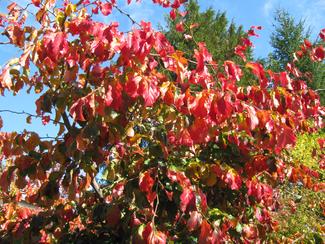by Vancouver Island Master Gardeners Association
Latin name: Parrotia persica
Common Name: Parrotia, Persian witch hazel, Persian Ironwood
This choice deciduous tree is found in Iran south of the Caspian Sea, and is the single member of its genus in the witch hazel family. It provides visual interest in all seasons but like other members of this family is best known for its dramatic red and gold foliage colours in the fall.
Parrotia,is a slow growing medium sized tree that can be grown as either a multi-stemmed or single trunk plant. The tree displays a dense, rounded canopy in the summer which provides nest habitat for a variety of birds. In fall the amazing greens, reds and golds change colour gradually even varying completely from year to year. Parrotia flowers early in the spring and the small brownish “witch-hazel” blooms are often overlooked. When abundant they manage to give the tree a reddish cast against the sky. The smooth grey bark exfoliates in patches that when first observed might be mistaken for rodent damage. As the tree ages however, the bark develops a nice textured appearance.




Photos courtesy: Phyllis Fafard and Milner Gardens & Woodland.
| Attribute | Description |
|---|---|
| Form: | Multi or single stem – upright, dense and spreading. |
| Foliage type: | Simple, alternate, ovate, leathery leaves with wavy shallow toothed edges. 100 – 150 mm. |
| Height/Width: | 8 – 12 m with 6 m spread. |
| Hardiness Zone: | 5 - 9. |
| Exposure: | Full sun will give best colour. |
| Flower Colour: | Brownish purple bracts with reddish stamens – no petals. Borne before the tree leafs out in early spring. |
| Leaf Colour: | Purplish in spring turning medium green. Spectacular colours in fall including yellow, gold, orange, pink and interesting mixtures as the green disappears. |
| Flower Time: | February – March. |
| Preferred Soil: | Has a wide range of soil tolerance including alkaline soil, prefers good drainage. |
| Watering: | Regular watering. |
| Other: | Parrotia is not named for its amazing fall colour but instead after its discoverer, a German plant collector, Dr. W. F. Parrot in the 1830's. Makes an attractive accent tree in an urban setting. In Milner Gardens & Woodland, the Parrotia persica can be found at several locations in the Gardens. |

